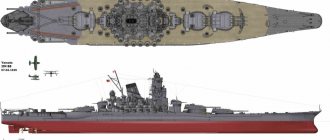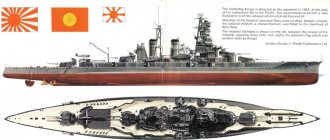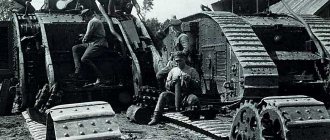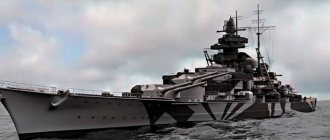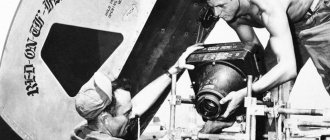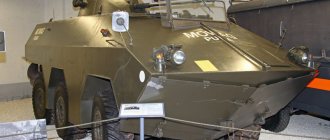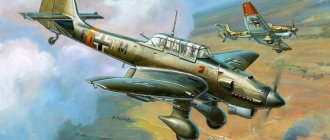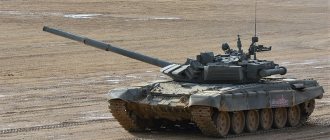Prerequisites for the appearance of Scharnhorst-class battleships
According to the terms of the Treaty of Versailles, signed in 1919, Germany could not have ships with a displacement of more than 10,000 tons. In the early 30s, the German fleet planned to update its naval weapons. Three new Deutschland-class cruisers were laid down. Prussia decided to ignore the previously agreed upon terms and designed ships that exceeded the previously agreed upon parameters. Deutschland received a carrying capacity of 12,000 tons. Their firepower and enhanced armor against the backdrop of their still small size for dreadnoughts contributed to a new unspoken name - “pocket battleships”. In response, France also began building a ship much larger than it could afford under the Treaty of Versailles.
The French Dunkirk was significantly superior to the new German battleships. To maintain balance at sea, Prussia needed to create even more powerful ships. In 1933, Adolf Hitler came to power. After analyzing the situation in the world, the new Reich Chancellor ordered the construction of two new battleships, the armor of which could withstand an attack from the enemy.
The battleships laid down in 1934 were redesigned and in May of the following year the construction of two Scharnhorst-class ships, which according to the design had a significantly larger displacement, resumed at German shipyards.
Model of the Scharnhorst-class battleship
Premium battleship tier 7. — Scharnhorst (1936) Flashed iPhone.
Date: 10/29/2017 | Posted in Reviews , Community | 131 comments |
Scharnhorst... How much bitterness and bitterness have merged in this sound for the heart. You'll see him one day. And despite all the attempts, you will understand that the Coloradoan is a moose. That Gneisenau, brother, brother, will not be able to break Sharik! The armor is strong! And tanks are fast. And DPM YabAshit is passion! Noggato will also immediately taste, Who is the Daddy, who is the barge in battle... There are miracles there! With a hard torpedo, Scharnhorst turns everyone to hell...
If you still have dollars in your stash and the crisis hasn’t put you off too much, then pay attention to the premium tier 7 battleship Scharnhorst. And if Gneisenau is the first iPhone in the village, then Sharik is an iPhone 4S, stitched and with a beautiful panel with rhinestones. For which any Svetka will happily grab both cheeks more than once or twice. So you understand. In the game, the battleship Scharnhorst is a racially loyal Aryan, truly historical and loyal to the Fuhrer to the end! And now let’s plunge a little (up to our fucking ears) into History...
STORY
A “no” not said in time often means a silent “yes”. This is exactly what Germany was guided by in the 30s, carefully, in small, leisurely steps, restoring its navy. The firstborn of its resurgent core were the Deutschland-class battleships, ships that were in many ways unique and original for their time. There was still silence on the banks of the Thames. The French neighbors, showing concern, responded by laying down the Dunkirk, a fast watchdog with 330 mm guns, capable of catching up and dealing with any of the German “pocket battleships”. The concept of a highly autonomous diesel raider has increasingly begun to become vulnerable. The third battleship of the Admiral Graf Spee series was slightly modified in order to increase and strengthen its armor, but this was a half-measure. The German admirals already needed a next-generation ship to work in the Atlantic - it had to maintain its high-speed and autonomous qualities and at the same time not be afraid of meeting with French hunters. Fleet Commander Admiral Raeder made a proposal to further change the Deutschland project, two of which (battleships “D” and “E”) were being prepared for laying. The idea was to install an additional, third, main caliber turret while increasing the displacement to 15–18 thousand tons. At the beginning of 1933, the project concepts set the conditions: the new ships must be able to withstand the French Dunkirk. Consideration of options began - from a displacement of 18 tons. and nine 283 mm guns up to 26 thousand tons with six promising 330 mm guns. The latter seemed more promising, and it was this that was taken as the basis for further development. Hitler's rise to power unexpectedly made adjustments to the development of large-tonnage military shipbuilding. At the beginning of his already official career, the newly-minted Fuhrer did not want to once again frighten the British by building as many as 26,000-ton ships, the size of which was already an outright mockery of the Treaty of Versailles.
Hitler called on the admirals to calm down their ardor and appetites and build battleships “D” and “E” like the “Admiral Graf Spee” with even more advanced armor (220 mm - belt, 70-80 mm - main armored deck). The ships “grew fat” to 19 thousand tons, but in Berlin they thought that the forbidden 19 tons were still more modest and inconspicuous than those that were generally beyond the 26 tons. On January 25, shipyards in Wilhelmshaven and Kiel received orders for the construction of two battleships, the laying of which took place on February 14 of the same year. In 1934, France, continuing to express concern, announced the laying of the second ship of the Dunkirk class, the battle cruiser Strasbourg. The naval elite began to beg Hitler not to reproduce ships that were obviously inferior to a potential enemy, but to give the go-ahead for reworking the project. Considering the silence that reigned on the island, the Fuhrer gave permission to increase the displacement of the new ships and add a third tower. On July 5, work on the battleships “D” and “E” was suspended, and their redesign began. At first, they decided to install the main caliber turrets in a very interesting way: one in the bow, two in the stern, thereby, according to the designers, a greater concentration of fire was achieved back in the event of a possible pursuit.
At the same time, the opinion was first expressed about including in the project the possibility of rearmament with guns of a larger caliber - 330 or 380 mm. Soon, the defensive arrangement of the main caliber turrets was abandoned in favor of the traditional one: two at the bow, one at the stern. The ship's power plant has undergone major changes. Since diesel engines with the appropriate power, capable of accelerating a ship with a displacement of 26 thousand tons, existed only on paper, it was decided to use a steam turbine power plant with high-pressure boilers of the Wagner system. Only such installations could provide the new ships with a speed of 30 knots.
In March 1935, when the drawings and other documentation were ready, the question arose again of increasing the caliber of the guns and placing either nine 305 or 330 mm guns, or six twin 350 or 380 mm guns. The fleet command insisted on maximum sizes, but then, still unsure of the reaction of the “peace-loving islanders,” Hitler ordered that for now we limit ourselves to the initial nine 283-mm cannons. The consolation, of course, was that these were new Krupp guns, more powerful and long-range than those installed on the Deutschlands. In an effort to reassure the British and give his actions at least some kind of legal framework, Hitler signed a naval agreement with Britain, emphasizing that he considered France to be the main enemy and offender. The Germans promised the British a guaranteed triple superiority of the British battle fleet over the German one: 477 thousand tons of displacement versus 166 thousand for Germany. The British thought and agreed. The Versailles restrictions finally collapsed - the Germans were able to build their fleet completely legally. In the spring and summer of 1935, new ships, which received the names “Scharnhorst” and “Gneisenau”, which were significant for the German fleet, were officially relaid: on May 3 - “Gneisenau”, on June 16 - “Scharnhorst”.
Source.
Author: Denis Brig
The ship was built in Wilhelmshaven, Germany. Launched on October 3, 1936. It entered service on January 7, 1939. The ship is sometimes called a battle cruiser (which in my opinion is more correct). Since it was originally built as a large Spee, but was rebuilt, and grew to the size of a rather sickly armored vehicle, leaving the guns of the Most Important Caliber somewhere in the cozy gap between the heavy ratters with their 200+ mm blanks and terrible suitcases from 300+ mm. battleships The ship, by profession, worked as a raider ala Cossack, distributed non-illusory ones to the weaker ones and skillfully grabbed, if necessary, from the stronger ones, in the spirit of the local gopniks in the area. During his dizzying career, together with Gneisenau, he sank several ships, an armed transport, one British aircraft and two torpedoes. I managed to fight with such battleships as Rinaun and Duke of York. But more often the British battleships saw only the stern of the dashing Kriegsmarine in the face of Sharik and the foam trail from the wake. And since everyone was slow-moving, they could not do anything to Scharnhorst. Bye…
After 4 years of his career, our gallant Soldaten of the northern waters finally confused all the shores, for which he snatched the most from the national team of fighters from sunny Britain. Like a true Aryan, he fought the battle to the end (from the beginning of the battle with the heavyweight, having lost almost all the towers), and naturally not a single officer escaped. That same evening, Admiral Bruce Fraser, on board the battleship Duke of York, will praise the untimely deceased brave sailors from Scharnhorst and drink a glass to their repose:
“Gentlemen, the battle with Scharnhorst ended in victory for us. I hope that any of you who ever have to lead your ship into battle against a much stronger enemy will command your ship as valiantly as you commanded the Scharnhorst today."
It is noteworthy that in that battle one of the decisive roles was played by the Belfast chief with his radar. But more on that next time. Now let's see what we get for 9700 doubloons. This is the current price of this ship, which is good in all respects...
TTX
Carcass.
Combat effectiveness points, also known as HP - 56,300 Armor - from 13 to 360 mm Anti-torpedo protection, reduction in damage from torpedoes - 24%
Sharik's carcass is large. The body length is 235 meters, width is 30 m. Like most Germans, it takes a lot of white damage inside. Not as much as the newly minted Nelson Mandela does (Lk 7), but still some Fiji sitting by in the smoke can throw up to 10 pieces in literally two minutes. And if there are a couple of such enthusiasts nearby, and you also go on board to them... That is, an opportunity to quickly try out the best that Sharik produces. A maneuver called “fuck off at a waltz pace.” And yet he does it very well. Fortunately, maneuverability and speed allow, unlike some Corolado. The captain of which will simply abandon the cozy armchair of the conning tower and go to the cabin to drink brandy for the last time.
Scharnhorst, with proper management, will have time to move away from the dangerous sexual position, shoot the shabby ratter as he retreats, treat Fiji with torpedoes in the smoke, and only then have fun shooting at the other end of the map. Yes, of course, Gneisenau is faster, which I personally think is not historical, since Sharik overtook his brother in testing. But we have what we have. And in the game we have practically the same stock Gneisenau, BUT with completely different main battery guns...
GK
283 mm L/54.5 Drh LC/34 - 3 x 3 pcs. Rate of fire - 3 rds/min. Reload time - 20 s. Speed horizontal guidance - 7.2 deg./s. Turn time 180° - 25 s. Firing range - 19.9 km. Maximum dispersion - 260 m.
HE shell - 283 mm Spr.Gr. L/4.5 Kz.
Maximum damage of a HE projectile - 3200 Probability of fire from a HE projectile - 20% Initial speed of a HE projectile - 890 m/s. The mass of the HE projectile is 315 kg.
AP shell - 283 mm P.Spr.Gr. L/4.4
The maximum damage of an AP projectile is 7600. The initial speed of an AP projectile is 890 m/s. The mass of the AP projectile is 330 kg.
Someone might say that these are our beloved main battery guns from the cruiser Graf Spee. But that's not true. I want to please you right away - this creation of German gunsmiths is an improved, modified and patched (2.0) version of the guns from the Deutschlands (Count Spee). The ballistics of the new guns, due to the increase in barrel length, has improved slightly, as well as the firing range. The reload speed remained the same, horizontal guidance and 180 rotation are identical, BUT. There is a bold but. The damage from the AP shell dropped by 1000 compared to the Spee main gun. Likewise, the initial velocity of the shells dropped from 910 (Spee) to 890 (Scharnhorst) ms. But despite these numbers, the new guns leave only a pleasant impression.
The shells do not fly for long and most often hit the target. God forbid you from the guns of Dunkirk, penitents. If we want to hit the target at 19 km, then most likely we will hit it, it’s not even necessary to pray to the god of randomness. The ballistics of the projectiles are on par, they fly beautifully, quickly and accurately, despite the stated dispersion characteristics (261 m). But this is not so important, because Scharnhorst was created for combat at medium and close distances. It is against them that the proud son of the Aryan people raises his head. Unlike Gneisenau, we already have 9 guns, smaller ones and less damage. But finally, from a short nasal salvo of 4 suitcases, all 6 smaller suitcases are already flying, and they are flying with a rather pleasant frequency.
For example, you are flying all beautiful to Gneisenau in the thick of battle. And suddenly you find yourself at a distance of 10-12 km from three cruisers. As was permissible in the spring ranked battles. Familiar situevina? There are two development options for you.
First: try to hit at least someone with your few main guns, receiving kilograms of mail from Pensacola, Miok, Furutak, Cleveland, Fiji and other vultures who will take great pleasure in showing you their sloping sides for a couple of seconds. And you, while loading your huge 380 mm balalaikas, will curse Lesta, the Almighty, and the Chinese rand for another 26 seconds, while nearby, from the rats, you will hear mocking giggles, and sometimes outright laughing. But thank God, it won’t be long, because they will burn you to hell very quickly, throwing 4 fires, and a bunch of land mines into the superstructures and huge extremities. And, unlike Nelson, the healer will no longer help you, because he won’t even have time to do CD. And the second option and the surest one is to turn the pelvis around and press on the gas behind the nearest island, praying that they will leave you alone.
It's a completely different matter when Scharnhorst finds himself in a similar situation. He will simply fall in love with each cruiser one by one, with German pedantry and accuracy, fortunately the rate of fire of the guns allows, and the caliber of the main battery will not give a chance for a draft. Particularly zealous ones will be scared off by secondary guns and torpedoes. Also, our guns are quite capable of offending almost any torpedo of their level. (How many times has the author gotten into such messes... Once Kiev jumped out at me in battle from behind the Buyan Island at a distance of 10 km. Having received a volley of landmines on half the face, Kiev did not try its luck by running back, but stood in the smoke in front of the island, and After some time, I received two tasty torpedoes on board, safely sinking to the bottom. So to speak, justice has triumphed, and it’s also nice to knock out a wedge with a wedge.)
In general, the guns are not bad, although they could be better.
PMK
150 mm L/55 SK C/28 - 4 x 2 pcs.
Firing range - 5.3 km. Rate of fire - 8 rds/min. Reload time - 7.5 s. Chance of fire - 8%
105 mm L/65 Dop. L. C/31 - 7 x 2 pcs.
Firing range - 5.3 km. Rate of fire - 17.91 rounds/min. Reload time - 3.35 s. Chance of fire - 5%
150 mm L/55 MPL C/35 - 4 x 1 pc.
Firing range - 5.3 km. Rate of fire - 8 rds/min. Reload time - 7.5 s. Chance of fire - 8%
With a full build-up of the captain and modules + the flag on the secondary battery, we will get 8 km of fiery hell, which will be a good help when we need to hit the enemy in a dagger attack. When the main battery is still on the CD, and a dangerous carcass is spinning nearby. To give you an idea of the importance of secondary guns on German ships - with my playing style focused on secondary guns - 20% of the enemies were destroyed by Manual Secondary Fire Control.
In general, the Germans are definitely worth training in only two options - secondary gun - air defense. But for me personally, Scharnhorst, even without any BOP modules and air defense handles, shoots down airplanes of its level quite well. And in general, I feel like Sharik’s air defense is OK, and I considered it unnecessary to spend money on strengthening the air defense. The only ones to be wary of are Lexington and the Nines. But they will fuck you anyway if they want, if they deem it necessary, and since we are mostly bombarded with levels 5-6-7, the chance of running into a fierce aircraft is very small and tends to zero. At least I was so lucky only once.
For those who do not know the characteristics of air defense:
20 mm Flak 38 - 10 x 1 pc. average damage per second - 30 firing range - 2.01 km.
37 mm Flakzwilling 30 - 8 x 2 pcs. average damage per second - 20.8 firing range - 3.51 km.
20 mm Flakvierling 38 - 5 x 4 pcs. average damage per second - 30 firing range - 2.01 km.
105 mm L/65 Dop. L. C/31 - 7 x 2 pcs. average damage per second - 116.2 firing range - 4.5 km.
As you can see, the long-range aura does the best damage, and accordingly, if you take Manual Air Defense Fire Control + Air Defense Module + BOP+UOP. Then we will get the best air defense at the level , and enemy planes will even be under the threat of barriers. NKVD detachments with maxims will not want to fly to us. And those who commit suicide will quickly go into a fiery tailspin and automatically convert to Islam. In reality, who can scare us is the torpers from Lexington with his large fan in the form of a comb. But with our maneuverability, we can escape quite easily and receive a maximum of 30K damage. So Scharnhorst’s air defense is in perfect order.
Torpedoes:
533 mm Drilling - 2 x 3 pcs. Rate of fire - 0.88 rounds/min. Reload time - 68 s. Speed horizontal pickups - 25 deg./s. The time of rotation of the TA by 180° is 7.2 s. Maximum damage - 13,700 Torpedo speed - 64 knots. The torpedo range is 6 km. The visibility of torpedoes is 1.3 km.
The torpedoes are completely identical to the Gneisenau. The range is quite acceptable, these are not short stumps from Atlanta and Soviets that can be implemented once in a thousand battles. And not 8 km of spears from the Japanese who are constantly provoking us to throw them into the unknown and into the void. No. 6 km is exactly what is needed in close combat. And the angles at which the fish are released are some of the most pleasant in the game, and will allow you to feed oncoming galoshes almost every minute with a portion of Bovar sausages almost without changing course. The visibility and speed of torpedoes are also quite pleasant and often do not give cruisers a chance in a clinch (although they rarely survive to this point)
A couple of times I even planted torpedoes on nimble destroyers. What most likely caused them a state of cognitive dissonance and a burning desire to sell the ship and generally abandon a career on destroyers.
When clinching, torpedoes are very helpful against plump and ruddy armored tanks, which at level 7 still act like fools out of habit, completely forgetting about the interesting feature of their colleagues of the 3rd Reich. What's interesting is that when we clinch with Gneisenau, we have a chance to land on torpedoes, which is quite funny when you both go to port having grabbed 3 torpedoes.
Torpedoes and secondary guns provide the opportunity to play tough aggression and vigorously push the flank. While the LCs are polishing the blue line, and the cruisers are pissing like little kittens from the opportunity to melt under the focus, we, like the armored Mercedes of the authority Kolya Nalimsky, fly into the enemy meeting and shoot everyone with everything that shoots, cutting off the enemy’s pathetic attempts to somehow stop you . The most important thing here is that you are supported in time, otherwise the stunned enemy will quickly come to his senses, press F3 on you, and the chance that you will leave unharmed will no longer be so obvious and simple. As a last resort, you can take a couple of ratters and perhaps a destroyer with you, fortunately there are opportunities for this.
Maneuverability:
Maximum speed - 30 knots. Circulation radius - 800 m. Rudder shift time - 14.5 s.
Our maneuverability is good and brings us closer to the level of heavy cruisers; our circulation radius is better than that of Gneisenau at 30m and worse than that of most classmates. Therefore, you should not try to turn around in the strait or near the islands. Don't forget that our rook is the longest in its class. Almost 240 meters of disgrace, so you should think through your maneuvers in advance.
In general, it feels like Sharik is easy to control, and is somewhat similar to Dunya; cruising qualities most likely predominate. The rudders obey perfectly and almost immediately respond to the helmsman’s desires to tuck away those torpedoes coming at us. You can completely drive a destroyer and never grab torpedoes from it, fortunately it will throw them at least somehow just to get into invisibility and not shine again. Our speed also allows us to show the best qualities of a raider - to suddenly attack, cut down a couple of ships and just as quickly get away before heavy artillery arrives in the form of British LK or Amer.
By installing the Steering Gear Mod 2 upgrade, we get 11.6 seconds of shift time, which is almost the same as Dunkirk or Gnaeus. In general, speed is our everything, we play and live from it. And in this case we live quite a long time and quite well.
Disguise:
The visibility range from ships is 15.66 km. The visibility range from aircraft is 12.42 km. Visibility after a main battery shot in smoke - 11.7 km
The camouflage itself is not bad, but it’s not worth worrying about, because with such a vigorous reload, Sharik still doesn’t have time to disappear from the enemy’s sight for the duration of his CD, and we can still escape without any invisibility.
Counteraction to classes.
Destroyers:
For us, unlike other armored vans, they are not so dangerous. The Kokolibre can still be a good help in the thankless shelling of the little brats, and a fully pumped up secondary gun will not leave a chance for the little fuckers during a dive. The maximum that you will face in this case is a couple of torpedo hits, but the reward for destroying one destroyer will be much more significant, since it comes from the percentage of HP taken from the enemy. And an extra frag never bothered anyone, right? The danger for us is represented by all sorts of cross-eyed scoundrels imprisoned in invisibility, who, out of old habit, strive to impale us on a narrow fan. Use the anti-torpedo maneuver more often, zigzags and don’t set the side if there is even a small chance that a small fearless ninja flashed in that direction for a couple of seconds. It is also worth mentioning that our PTZ in relation to the length of the body is not very large. And catching a couple of torpedoes from the Japanese in the bow or stern will be very painful for us, up to half the damage that cannot be healed. And this is already sadness, sadness and disability of group 3. The Germans and the Soviets are not scary, if you have the PPP perk, their shells will still hit you like peas against a wall. In general, Scharnhorst, at his level of battleships, is the only one who can punish presumptuous assholes. A lookout on a hawk flying ahead can also help with this. When you take a superintendent and a gold consumable, there are already 5 of them, they will highlight the fish and bring the torpor itself to clean water. The ballistics of your main battery guns are also very favorable, and German land mines will quickly send any destroyer to a concentration camp.
Cruisers:
I think everything is clear. The best food for Scharnhorst. We were created to enslave and oppress cruisers; the main battery caliber leaves no chance for drafts. There will be few problems with penetrating the nose of the citadel, but no one has canceled white damage.
If you calculate, then Sharik produces more than 200,000 AP damage per minute, which is quite enough for a couple of full-length cruisers, and will unpleasantly surprise battleships. Of the cruisers, you should only be wary of the Shchors, Molotovs, and other lovers of setting fires from afar. In general, our main goal in the game is to sink as many cruisers as possible in battle, and we have everything for this.
Battleships:
With our colleagues in the shop, not everything is as clear as we would like. On the one hand, a good firing range, shell ballistics and armor penetration, coupled with DPM, give us the opportunity to punish armored vehicles, but on the other hand, 280 mm guns... Most often, 2 - 4 k of damage will fall from a salvo, while splashes can come at us and 8 - 14K white damage. Of course, you can easily knock out a couple of strongholds from North Carroline with 16 km on board, and Nagato with 6 - 8 km. But you will never get the same damage figures as from Gneisenau guns, 10 - 20 per salvo. But it is much easier to hit the gun from a long distance, thanks to the rate of fire and short flight time of the projectiles. You can also try land mines, but they are still not as good as BBs, and are used quite rarely, situationally.
But everything changes dramatically when we reach the LC at a distance of less than 10 km. Here we are the Law and the presidents of this small country called close combat. The most important thing is to be able to correctly implement torpedoes, and the secondary gun will play its incendiary role. And when the enemy is burning with all parts of the carcass, snatching the next portion of torpedoes in the nose and on the side, receiving every 20 (and when taking the Desperate perk less) seconds another BB significant splash, he will curse the day he sat down at the steering wheel of this vacuum cleaner, and in the next time it sees you at a short distance it will dart in the opposite direction, occasionally farting with its stern turrets. Because none of the ordinary LCs in close combat will be able to oppose you with anything other than BB-blanks, which will ricochet and get stuck in your long nose.
Bow outing of must-haves, although you shouldn’t be afraid to constantly connect the stern turret, believe me, the armor of the German tier 7 battleships is good and feels no worse than that of Bismarck and Tirpitz. If necessary, do not be afraid to turn the side towards the enemy for a short time. Most likely the armor will withstand a couple of swims, and certainly who’s going to pick out your citadel for you. It is worth noting, perhaps, only such Sharik or Gneisenau as opponents. Such encounters are generally undesirable and try to avoid them for a more comfortable game.
Aircraft carriers:
Everything was said in the section about air defense. For us, the aircraft is not scary, the most it can do is change our course a little, but lose from 10 to 30 aircraft on our sides. Often we will use main guns to punish level 6 aircraft who, having lost all their planes, will quietly cry somewhere far from the thick of the battle. By the way, our shells are simply wonderful at pulling out citadels from such wretches in all planes and projections. Aircraft carriers are not rivals for us and will not draw much attention to themselves.
Overall rating.
The battleship Scharnhorst is a vivid example of bending over for money. And unlike many other premium ships, it is the least demanding of the player’s skill and is more than comfortable for a casual and relaxed game. You can put a person who is not playing at all on Sharik, and he will still remain in the black in terms of sulfur and experience at the end of the battle.
I would also like to add a few words about the beauty of the ship’s architecture; Dunkirk used to take first place for me. But now Scharnhorst boldly moved him. Let me quote from the book:
..For sailors, a ship is something animate, having its own life and its own character. There are ships that seem gloomy and even angry; they, like some people, lack liveliness and warmth. Scharnhorst definitely had a soul. Moreover, this ship was beautiful. The wake behind it trembled with that amazing soft rocking motion that is characteristic only of the wake of a battleship. The ship seemed to radiate happiness, and this spirit spread to the entire crew, giving rise to pride that was felt by all the sailors of the Scharnhorst - from the captain to the most junior in rank. With its grace, elegance, and harmonious lines, the Scharnhorst was, in the opinion of any sailor, very beautiful...
In general, Sharik is a good hard worker and earns every fight very immodestly, allowing him to bring 200K pure sulfur in a bad fight. But for a better game, I would advise you to buy it after completing the full branch of German battleships in order to better understand the whole concept of playing on this branch of ships. For Scharnhorst himself, the ideology is better suited - Beat the Weak, run away from the Strong. And don't be afraid to take risks. Risky, fast-paced play at a dagger-like distance is the element for this unique, universal and good premium battleship in all respects. It is well worth the money as a good alternative to the shareware Missouri.
Author of the publication
offline 2 years
SET_UP_TO_MANEUVER_
Comments: 1286Publications: 65Registration: 10/21/2017
Construction and armor
The main armor belt of the new battleships was located from the front to the rear main caliber turret and had a thickness of 350 mm. The conning tower and main caliber were protected by 200-350 mm steel sheets produced by Krupp. The underwater part was equipped with an additional 45 mm bulkhead.
The standard displacement reached 32,100 tons; 44% of the total carrying capacity was spent on armor. The maximum length of the vessel was 235 meters. The power plant included three Parsons-type steam turbines and 12 boilers. The movement was provided by three propellers and reached a maximum speed of 31.5 knots.
According to the project, the ship's crew was 1,669 people. During the war it was increased to 1,900 sailors and 70 officers.
Detection[ | ]
The search for the sunken battleship has been undertaken since the late 90s of the 20th century. In September 2000, a joint expedition organized by the BBC, the Norwegian Broadcasting Corporation and the Norwegian Navy began work. The expedition was based on the research vessel Sverdrup II, owned by the Norwegian Defense Research Centre. The wreckage was detected by side-scan sonar and identified as the wreck of the battleship Scharnhorst on September 10, 2000, using a remotely operated device. The location of the wreckage is 72°31′ N, 28°15′ E (coordinates different from those indicated in the logbook of the battleship HMS Duke of York), approximately 120 kilometers north-northeast of the North Cape, at a depth of 290 meters. The surviving part of the hull, about 160 meters long, lies keel up. The bow part (60-70 m long) was torn off (in the area of the captain's bridge), badly damaged and lies almost at a right angle to the surviving part of the hull. Presumably, the bow of the hull was torn off due to the detonation of the gun magazine of turret A of the main caliber guns, caused by a torpedo hitting the bridge area. Part of the aft end is also missing (immediately behind the surviving propellers and rudders). The surviving main part of the hull has split along its entire length (probably from hitting the bottom during diving) - there is a 2-3 cm wide crack along the keel. There are numerous traces on it from the impact of shells and torpedoes from British ships that hit the battleship during its last battle. Around the debris, sediment formed from bottom sediments 15-20 meters high[6][7].
Armament
- The main caliber consisted of 3 three-gun installations with a caliber of 283 mm 28 cm SKC/34. They were an improved version of the artillery systems installed on their predecessors, the Deutschland-class ships. The new guns could use three types of shells: armor-piercing, semi-armor-piercing and high-explosive. The firing range exceeded 40 km. The armor has been strengthened compared to the previous SKC/28 model.
- Like the “pocket battleships,” the Scharnhorst had 150 mm 15 cm SKC/28 guns. Their number was 12 units.
- Anti-aircraft artillery consisted of 7 pairs of 105 mm equipment, 8 pairs of 37 mm guns and 8 units of 20 mm machine guns.
- Mine and torpedo weapons - at the time the ship was commissioned, no such systems were provided. However, in 1941, the designers installed two underwater vehicles, which were not protected in any way.
- Aviation included 3 seaplanes and 1 catapult.
Main caliber fire control was provided by rangefinders installed in three parts of the ship. The system ensured simultaneous firing of two targets. With the outbreak of hostilities, Seetakt FuMO 22 radar stations appeared on ships, helping to detect enemy ships within a radius of several tens of kilometers.
283 mm 28 cm SKC/34
Notes[ | ]
- KBismarck.com.
Scharnhorst career timeline
(undefined)
. KBismarck.com (1998-2013). - The battle between the Scharnhorst and the battleship Duke of York was the last for the Scharnhorst.
- Scharnhorst General Information (unspecified)
(unavailable link). Retrieved June 15, 2007. Archived July 19, 2022. - The Duke of York expended 446 main battery shells, fired 31 salvos, and recorded at least 13 hits.
- Scharnhorst. The History
- BBC - History - World Wars: The Sinking of the 'Scharnhorst' (English). www.bbc.co.uk. Date accessed: February 24, 2022.
- Alf Jacobsen.
Battleship SCHARNHORST. - Moscow: Eskmo, 2006. - P. 237-249. — 304 p. — ISBN 5-699-14578-8.
Service
The first dreadnought to enter service was the Gneisenau, in May 1938. 7 months later, Scharnhorst entered service. Already on September 3, 1939, the battleships were attacked by British aircraft, but were not damaged.
In November of the same year, battleships of the Scharnhorst class, under the cover of their destroyers, went to sea. A few days later they discovered the British cruiser Rawalpindi, which only had 152 mm guns on board. It took several minutes for the English ship to turn into a pile of burning metal. The rescue of the surviving enemy crew was interrupted by the appearance of the British destroyer HMS Newcastle. The German ships quickly retreated.
In April 1940, a squadron of German ships, which included the described battleships, set off for the shores of Norway for a landing. The Scharnhorst was supposed to provide fire support for the Marines. The RAF noticed the enemy's movement and launched an attack. The anti-aircraft artillery of the battleships provided reliable protection against aircraft. The British had to retreat. However, they called for reinforcements. A few hours later, the Royal Navy battlecruiser HMS Renown appeared on the horizon, accompanied by 8 destroyers. German battleships had to flee to the waters of the Arctic Ocean.
A couple of months later, the battleships met the British aircraft carrier Glories, rebuilt from a light battlecruiser, which was accompanied by two destroyers. As a result of a fierce battle, the British ships were sunk, the battleship Scharnhorst was seriously damaged - 48 people died on board. One of the propellers failed, but the German battleship, through its own efforts, reached Trondheim, Norway, and was repaired. There he was again overtaken by the British Air Force. New damage was avoided - the Scharnhorst went to Kiel, where it stood for repairs for about 6 months.
Over the following years, the dreadnoughts sank many tankers and passenger ships in the Atlantic Ocean. In cases where it was not possible to independently attack ships, they transmitted information to German submarines, which caught up and destroyed enemy military and transport ships.
Breakthrough across the English Channel[ | ]
Main article: Operation Cerberus
While in Brest, German ships became targets of constant air raids. In July 1941, Scharnhorst moved to the port of La Rochelle, south of Brest. Warned about the Scharnhorst's departure from the port by aerial reconnaissance and Resistance agents, the Allies were confident that this was another raid. To prevent a raid, they scrambled 15 RAF Halifax heavy bombers. The damage caused by the bombing was severe enough to force Scharnhorst to return to the port of Brest for repairs. Damage from the bombing, together with that received during the raids, as well as problems with cooling the boilers, kept the Scharnhorst in port until the end of 1941, when it was decided to send the Scharnhorst and Gneisenau, as well as the heavy cruiser Prinz Eugen, back to Germany. Since it was very risky to try to break through the North Atlantic, on February 11-13, 1942, three large ships, accompanied by dozens of minesweepers and other auxiliary vessels, made a breakthrough through the English Channel, called Operation Cerberus. The British were not prepared for such a decisive and unexpected breakthrough, their coast guard was not ready to stop the breakthrough, and the jamming of British radars by the Germans did not allow an air attack. However, both Scharnhorst and Gneisenau were damaged by mines: Scharnhorst by two, and Gneisenau by one.
Repairs kept the Scharnhorst docked until March 1942, after which it departed for Norway to rendezvous with the battleship Tirpitz and other German ships to attack Arctic convoys bound for the Soviet Union. The next few months were devoted to training and acclimatization, ending with the bombing of Spitsbergen together with Tirpitz.
Death of battleships
In 1942, during the redeployment of German battleships from Brest to Germany, the Gneisenau hit a mine. Immediately upon returning to his native harbor, he began repairs. A few days later, British aircraft carried out a raid and one of the bombs dropped hit its target. The ship could not be extinguished within 3 days. It took about 2 years to restore it. Germany could not afford this. The Gneisenau was never repaired and was dismantled after the end of the war.
On December 25, 1943, Scharnhorst went to sea as part of destroyers. British cryptographers were able to decipher the encryption sent shortly before the start of the new operation, and knew in advance about the plans of the German fleet. The British managed to prepare and sent their combat units to intercept. The crew of the German battleship fought fiercely until the last minute, but its fate was sealed. Later, the British Admiralty admitted that the Scharnhorst command died like real heroes, repelling the attack until the last minutes. Of the 1,968 people, only 36 sailors survived.
Raid into the Atlantic[ | ]
Main article: Operation Berlin
From January 22 to March 22, 1941, Scharnhorst and Gneisenau operated in the Atlantic under the leadership of Admiral Günther Lütjens. On February 3 they passed through the Denmark Strait and the next day reached the southern tip of Greenland. An attempt to attack convoy HX-106 on February 8 failed due to the appearance of the British battleship Ramilles. On February 22, four Allied merchant ships were sighted and sunk east of Newfoundland. In conditions of very weak air patrols of this sector of the Atlantic, the raiders were able to avoid a collision with the British navy. Between 7 and 9 March they attacked convoy SL-67, but were forced to retreat when the battleship Malaya appeared. On March 15, an unguarded convoy of Allied tankers was attacked southeast of Newfoundland. The next day, another mixed convoy was discovered and attacked, with 13 ships sunk, four of them by the Scharnhorst. This was the last attack before returning to the port of Brest on March 22. During the voyage, the Scharnhorst sank 8 ships, with a total tonnage of 49,300 tons, with a total group count of 22 sunk ships and a total tonnage of 115,600 tons[3].
